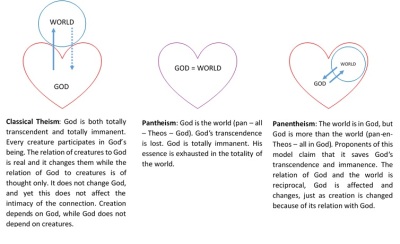I have just posted a new sub-page on my blog, which will contain abstracts and links to my official publications. I will try to explain the content of each one of them in several steps.
 My first article in English was published in May 2013 in Theology and Science, a journal edited by the Center for Theology and the Natural Sciences in Berkeley. It’s title is quite sophisticated: Hegel and Whitehead: In Search for Sources of Contemporary Versions of Panentheism in the Science–Theology Dialogue. You can read an abstract here.
My first article in English was published in May 2013 in Theology and Science, a journal edited by the Center for Theology and the Natural Sciences in Berkeley. It’s title is quite sophisticated: Hegel and Whitehead: In Search for Sources of Contemporary Versions of Panentheism in the Science–Theology Dialogue. You can read an abstract here.
First of all, what is panentheism about? It all goes back to one of the main concerns of our reflection about God, which has been the source of struggle for theologians over the centuries. On the one hand we acknowledge that God is totally different and unlike anything that we know by our sensual experience and intellectual reflection. God is totally and absolutely transcendent. He is omniscient (knows everything), omnipotent (can do everything), eternal, and above all – unchangeable. Therefore – according to St. Thomas Aquinas – while our relation to God is real and changes us, this same relation on the side of God is only a relation of thought (reason), because it cannot change God nor add anything to His essence which is pure act, without any hint of potentiality.
On the other hand we have to acknowledge that God is radically immanent, that is He is present in the world and all its aspects. Saint Thomas defines the very act of creation as a total dependence of every creature in its being on God. God is the source of the very existence of everything. Were he not present in contingent beings at every moment of their existence, they would perish at once. They actually exist because they participate in the infinite being of the Creator.
 And here comes the question: how does one bring God’s transcendence and immanence together into one model of His divine action? One of the possible answers goes back to Pseudo-Dionysius (5-6th century), and was further developed by St. Thomas Aquinas. It names three ways of our speech about God. The positive way enables us to formulate positive statements about the Creator. We may say for instance that God is good, and His goodness is revealed in creation (God’s immanence). But at the same time we must acknowledge that He is not good in the way that we are good. In other words, God’s goodness is unlike our goodness. This is the way of negation. Following it we realize that it is more appropriate for us to say what God is not, rather than what God is (God’s transcendence). And yet the connection with our human categories is not totally rejected. The third way – the way of eminence – saves it, claiming that God is good, but in an eminent way, which goes beyond any kind of goodness known to us. God is the source of all goodness, as His goodness is identical with His essence. This way of speaking about God is based on the doctrine of analogy, which I hope to explain in a separate entry.
And here comes the question: how does one bring God’s transcendence and immanence together into one model of His divine action? One of the possible answers goes back to Pseudo-Dionysius (5-6th century), and was further developed by St. Thomas Aquinas. It names three ways of our speech about God. The positive way enables us to formulate positive statements about the Creator. We may say for instance that God is good, and His goodness is revealed in creation (God’s immanence). But at the same time we must acknowledge that He is not good in the way that we are good. In other words, God’s goodness is unlike our goodness. This is the way of negation. Following it we realize that it is more appropriate for us to say what God is not, rather than what God is (God’s transcendence). And yet the connection with our human categories is not totally rejected. The third way – the way of eminence – saves it, claiming that God is good, but in an eminent way, which goes beyond any kind of goodness known to us. God is the source of all goodness, as His goodness is identical with His essence. This way of speaking about God is based on the doctrine of analogy, which I hope to explain in a separate entry.
This way of bringing together transcendence and immanence of God saves both of them and supports the classical Thomistic model of God- world relationship which I describe on the left side of the diagram below (click on the image to view it in a higher resolution).
 Aquinas’s view of God-world relation remained in a radical opposition to pantheism (the middle model on the diagram), which assumes that the world is God and God’s essence is exhausted in the world taken as a whole (an idea coming back today in the New Age and other “ecological” spiritual movements). However, commonly accepted and supported throughout the centuries, the classical model of Aquinas has been recently accused (beginning from the late 19th century) of overemphasizing God’s transcendence. God who does not have a real relationship towards His creation – says the main charge – is not the God of love. If creation cannot affect God, then He is not concerned with what is happening in the world. He is a God of philosophers, but not of the Bible.
Aquinas’s view of God-world relation remained in a radical opposition to pantheism (the middle model on the diagram), which assumes that the world is God and God’s essence is exhausted in the world taken as a whole (an idea coming back today in the New Age and other “ecological” spiritual movements). However, commonly accepted and supported throughout the centuries, the classical model of Aquinas has been recently accused (beginning from the late 19th century) of overemphasizing God’s transcendence. God who does not have a real relationship towards His creation – says the main charge – is not the God of love. If creation cannot affect God, then He is not concerned with what is happening in the world. He is a God of philosophers, but not of the Bible.
As a remedy to this crisis, some theologians proposed a new model of God-world relationship – panentheism. It suggests that the world is in God (a link to pantheism), and yet God is more than the world (a link to classical theism of Aquinas). See the right-hand model on the diagram above. Proponents of this version of God-world relation suggest that because the world is in God, it has to affect God, therefore He is not unchangeable anymore, and His eternity is affected by time. Moreover, when creating the world God decides to limit his omniscience and omnipotence, in order to make a space for our freedom and contingent events in the world. He is not a detached ruler, but a fellow sufferer who understands. And yet – according to panentheism – God is still transcendent, because He is more than the world.
 The panentheistic model has become very popular, and found many applications in contemporary theology, especially in the circles of theology and science debate, where it seems to be suitable in explaining theological implications of contingency and indeterminacy of natural events. However, at the same time, it raises some basic and crucial questions. The first and the most important among them refers to God’s transcendence. If the world is in God and affects God, then it has to share God’s essence (God’s nature or substance), which challenges the truth about God’s transcendence. Moreover, if creation of the world changes God and limits some of the attributes which are substantial for His divinity (e.g. omnipotence, omniscience, eternity), it is hard to agree that He is still the God we believe in. If this is the case, then the claim of panentheism’s proponents, who say that it gives right to both God’s transcendence and immanence, simply does not hold.
The panentheistic model has become very popular, and found many applications in contemporary theology, especially in the circles of theology and science debate, where it seems to be suitable in explaining theological implications of contingency and indeterminacy of natural events. However, at the same time, it raises some basic and crucial questions. The first and the most important among them refers to God’s transcendence. If the world is in God and affects God, then it has to share God’s essence (God’s nature or substance), which challenges the truth about God’s transcendence. Moreover, if creation of the world changes God and limits some of the attributes which are substantial for His divinity (e.g. omnipotence, omniscience, eternity), it is hard to agree that He is still the God we believe in. If this is the case, then the claim of panentheism’s proponents, who say that it gives right to both God’s transcendence and immanence, simply does not hold.
Contemporary panentheism has many faces and versions. The truth is that it also has a long historical tradition, especially in the philosophical reflection on God and God-world relationsip. It’s roots go back to ancient Egypt and Greece. In my article I concentrate on two philosophical versions of panentheism: the one which was proposed by Georg Wilhelm Friedrich Hegel, and the other developed by Alfred North Whitehead. The former philosopher may be regarded as the father of the modern version of panentheism, while the latter has become very popular in the contemporary science-theology dialogue. I ask the question of the possible relation between their versions of panentheism and the nuances in their understanding of God’s transcendence and immanence.
That’s it for now. It is a prelude to the main body of the article which I hope to summarize in the next episodes under the same title: Hegel & Whitehead.
